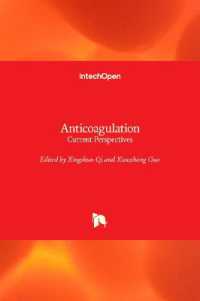- ホーム
- > 洋書
- > 英文書
- > Religion / Ethics
Full Description
The philosophical and theological study of aesthetics has a long and rich history, stretching back to Plato's identification of ultimate goodness and beauty, together representing the eternal form. Recent trends in aesthetic theory, however, characterised by a focus on the 'beautiful' at the expense of the 'good', have made it an object of suspicion in the Orthodox Church. In its place, Greek theologians have sought to emphasise philokalia as a truer theological discipline.
Seeking to reverse this trend, Chrysostomos Stamoulis brings into conversation a plethora of voices, from Church fathers to contemporary poets, and from a Marxist political theorist to a literary critic. Out of this dialogue, Stamoulis builds a model for the re-appropriation of Orthodoxy's patristic and Byzantine past that is no longer defined in antithesis to the Western present. The openness he proposes allows us to perceive afresh the world 'shot through with divinity', if only we can lift our gaze to see it. Dismantling the false dichotomy, philokalia or aesthetics, is the first step.
Contents
Translator's Introduction
Author's Preface
Part I. Philokalia or Aesthetics? The 'Dilemma' of Contemporary Orthodoxy
1. Kostas Zouraris: 'What We Call "Philokalia" Is Not the Same as Western Good Taste'
2. Father Alexander Schmemann: 'One Cannot Banish the Senses'
3. Nikos Matsoukas: 'Aesthetics Is a Lasting Victory over Distraction and Fragmentation'
Part II. Orthodoxy's Philokalic Aesthetics: The 'Both Together' of Patristic Teaching
4. 'Supra-Substantial Good': Dionysius the Areopagite and the Church Fathers on the Holy Trinity
5. 'Where Has Your Beauty Gone?': Anthropological Notes on the Beauty Lost by the Fall
6. 'The Heavens Tell of the Glory of God': The Orthodox Doctrine of Creation and the Problem of the Environment
Part III. 'Unutterable Beauty': Examples of a Philokalic Reading of Ecclesial Life
7. Nikos Gabriel Pentzikis: A Walk 'by the Seashore' and the Boundaries of the Church
8. The Elder Sophrony of Essex: The Remembrance of Death and the 'Conflict' with a Passion for Painting
9. The Elder Porphyrios, the Nightingale and the Current Debate on Aesthetics: Parallel Readings of the Elder's Discourses and Theodor W. Adorno's Aesthetic Theory
Afterword: Saints and Poets Perhaps .
Who's Who
Select Bibliography
Index






